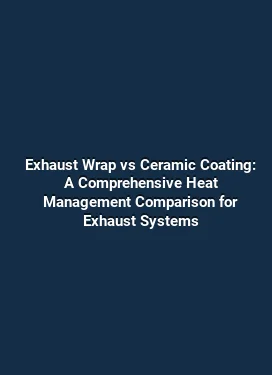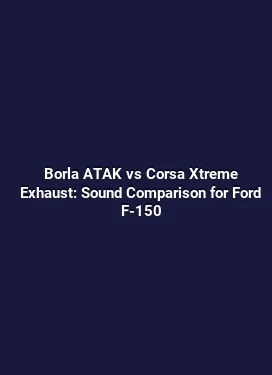How to Build a Custom Exhaust System with Mandrel Bent Tubing
Crafting a custom exhaust system with mandrel bent tubing is a project that blends precision, material science, and practical fabrication. A well-designed mandrel bent exhaust can improve flow, reduce heat buildup, and deliver a distinctive exhaust note without compromising structural integrity. This guide delves into the planning, material selection, fabrication, fitment, and tuning considerations that turn an idea into a dependable, high-performance exhaust assembly.
Design Considerations for a Mandrel-Bent Exhaust System

Designing an exhaust system around mandrel bending starts with understanding the engine’s power curve, backpressure goals, and the vehicle’s chassis constraints. Mandrel bends maintain a constant tube diameter through the bend, preventing pointwise constrictions that would otherwise create turbulence and pressure loss. A thoughtful layout balances performance gains with practical routing, weight distribution, and clearance from heat-sensitive components.
Key design considerations include the number and location of catalytic converters, the overall length of each pipe leg, and the configuration (single, dual, or quad exhaust). A well-planned path minimizes sharp secondary angles and avoids surplus length that adds weight and folds the flow back on itself. Throughout the planning phase, visualization tools or CAD sketches help anticipate clearance issues and verify that hangers, mounting points, and heat shields align with factory or aftermarket supports.
Tubing Diameter and Orientation

Selecting the correct tubing diameter is a balance between aiming for higher flow and maintaining sufficient exhaust gas velocity at lower RPM. Larger diameters reduce backpressure at high rpm but can dampen low-end torque if the system is oversized for the engine. A practical approach is to match the primary pipe diameter to the exhaust port size and the engine’s torque band, then adjust with secondary pipes or muffler characteristics. Orientation matters as well; pipes should follow a smooth, gravity-friendly path to avoid standing liquid gas pockets and to facilitate drainage of moisture during operation.
When planning diameters, consider uniformity along the primary path and how each section interconnects. In some builds, stepped diameters are introduced to optimize the transition from high-tear to high-velocity sections, helping to manage pressure waves without introducing excessive turbulence at joins. The aim is to preserve laminar flow where possible while accommodating necessary bends and transitions.
Material Selection and Corrosion Resistance
Materials commonly chosen for performance exhausts include stainless steel grades with varying corrosion resistance and heat tolerance. 304-grade stainless is a standard choice for mid-range durability and cost, while 409-grade stainless offers a lower-cost option with adequate corrosion resistance in milder environments. For extreme conditions or show-level builds, 316-grade stainless provides superior corrosion resistance, especially in coastal or salted-road environments. Tube thickness, often denoted by gauge, also impacts durability and heat handling; thicker walls reduce the risk of denting from road debris and heat cycling but add weight.
Corrosion resistance is not only about the pipe; hangers, flanges, and fasteners should be compatible with the chosen alloy to avoid galvanic corrosion. Coatings, heat shields, and careful routing to minimize road salt exposure can extend system life. The aesthetic choice—polished, brushed, or a coated finish—also influences maintenance requirements and curb appeal.
Choosing Tubing and Mandrel Bends
The heart of a mandrel-bent exhaust system is the tube geometry and the bend radius. Mandrel bending uses a centralized mandrel inside the tube to prevent collapse or wrinkling during bending, preserving inner diameter and reducing turbulence. This technique contrasts with crush bends, where the inner wall is squeezed to form the curve, often resulting in flow restrictions and hotspots. The result is a smoother inner surface that supports more efficient gas flow and more predictable pressure characteristics across the system.
In selecting tubing, the material, diameter, and wall thickness determine performance and durability. A consistent diameter throughout the primary path helps create uniform flow. However, some designs employ calculated transitions, such as stepped diameters, to optimize gas velocity at low rpm while enabling higher flow at peak power. The bend radius is critical: too tight a bend introduces sharp changes in direction that produce eddies and pressure spikes; too gentle a bend may require more space but yields easier fitment and lower noise resonance.
Mandrel vs Crush Bends
Mandrel bends maintain a smooth, true cross-section through the bend, preserving interior diameter and reducing the likelihood of flow separation. This is particularly important in high-performance applications where every fraction of a second in gas velocity translates to measurable gains in thrust. Crush bends, while cheaper and easier for some DIY endeavors, often create a bottleneck at the bend that can compromise throttle response and efficiency.
For enthusiasts seeking reliability and predictable performance, mandrel bends are worth the investment. The additional tooling and skilled fabrication required are offset by improved exhaust gas dynamics, especially when combined with larger-diameter pipes and robust hangers that keep the system aligned over time.
Material Compatibility and Finishes
Finish and compatibility influence maintenance and appearance. A straight-cut, seamless finish reduces creases where rust can initiate. Satin or mirror polish can enhance heat reflection and reduce heat buildup near heat-sensitive components. If a coated finish is preferred, ensure the coating can withstand continuous exposure to high temperatures without cracking or de-lamination. Coatings should be inspected after installation and during routine maintenance to catch any signs of wear or chipping early.
Compatibility with the vehicle’s thermal system, including oxygen sensors and catalytic converters, guides the selection of flange sizes and connection methods. Ensuring leak-free joints is essential for consistent performance, fuel economy, and emission compliance where applicable.
Fabrication Process: From Planning to Welding
Fabrication begins with precise measurement and mock-up. A well-executed mock-up uses reference points from the vehicle and adjustable stands to confirm fitment before cutting any material. Marking and verifying every segment ensures that the final alignment aligns with the system’s intended path and does not interfere with vital components like suspension, steering, or brake systems.
Welding quality is central to a durable exhaust. TIG welding with stainless steel tubes offers clean, precise welds with strong joints that tolerate heat cycling. For thicker or more corrosion-prone materials, appropriate joint preparation and post-weld cleaning reduce the risk of cracking. A consistent welding technique that minimizes heat-affected zones helps preserve material strength and appearance across the entire system.
Cutting, Fitting, and Welding Techniques
Precision cutting is essential. Using pipe cutters or rotary tooling with appropriate cutting wheels ensures clean edges that align correctly with flanges and connectors. When assembling, dry-fit each section and use alignment guides to confirm parallel surfaces and joint angles. Welds should be performed in uniform passes, with controlled heat input to prevent warping. After welding, deburring and cleaning remove sharp edges that could cause rust concentrations or snag under the vehicle’s heat shield.
Hangers and mounting hardware must be integrated into the design with consideration for thermal expansion and vibration. Flexible hangers at key points absorb movement and reduce stress on joints, promoting long-term integrity. For sound management, consider the placement of resonators and mufflers to balance tone with cabin acoustics and exterior noise regulations.
Quality Control and Testing
After assembly, pressure testing and leak checks verify joint integrity. A simple methods involves applying soapy water to welds and flanges while the system is pressurized with inert gas to identify bubbles at any seal. A more rigorous approach uses a vacuum or pressure test to confirm airtight seals across the entire layout. Visual inspection for consistent bead width and penetration helps ensure a clean, professional finish.
Testing should also account for thermal behavior. Thermal cycling simulates real-world conditions to identify potential weak points or warping. If any signs of movement or heat-induced distortion appear, rework may be necessary before the final installation.
Installation and Fitment: Vehicle-Specific Considerations
Installing a mandrel-bent exhaust requires careful alignment with the vehicle’s chassis and exhaust routing. The goal is to maintain ground clearance while avoiding contact with underbody components that experience heat or vibration. A detailed plan with attachment points, hanger spacing, and support brackets reduces installation time and improves reliability. When mounting, ensure that the exhaust sits at a slight downward angle toward the tail to promote drainage and reduce the chance of trapped moisture.
Fitment also hinges on the compatibility of flanges and connection types with the factory exhaust or any aftermarket components. Adapting flange sizes or adding adapters can simplify connections while maintaining seal integrity. It is essential to verify sensor placements and ensure that oxygen sensors are accessible for service without disassembly of the entire system.
Routing and Clearance
Routing should avoid sharp bends near heat sources and maximize clearance from fuel lines, brake lines, and wiring. A well-routed system reduces the risk of contact that could abrade hoses or cables over time. If the vehicle has a tight engine bay or complex suspension geometry, consider a segment-by-segment approach in which each piece is pre-fitted and validated before final welding.
Thermal management is another vital facet. Installing heat shields or reflective wraps around sections near the firewall or intake paths helps keep nearby components within safe temperatures. For off-road or performance builds, ensuring mud and debris clearance is also important to maintain consistent exhaust flow and prevent clogging from road grime.
Performance Tuning and Acoustic Considerations
Beyond raw flow, the exhaust system influences engine sound, throttle response, and overall driving feel. A well-designed mandrel-bent system can deliver a deeper, more authoritative tone without excessive cabin drone. The acoustic characteristics are influenced by pipe diameter, muffler type, length, and the position of resonators. When tuning, aim for a balance that suits the vehicle’s use case—quiet for daily driving, aggressive for track or performance-oriented applications.
From a performance perspective, the impact of a mandrel-bent system is often most noticeable in mid-to-high RPM ranges where flow becomes more critical. A consistent cross-section reduces flow separation and helps maintain high gas velocity through the system. This can translate into improved throttle response and a more linear power delivery profile, especially when paired with appropriate catalytic converters and exhaust manifolds that support the intended power band.
Noise, Vibration, and Harshness Management
Engine and exhaust resonance are shaped by the system’s geometry and mounting strategy. Proper positioning of mufflers and resonators can minimize in-cabin noise while preserving a robust exhaust note. Vibration management relies on sturdy hangers and isolation mounts that prevent a direct transfer of engine-induced oscillations to the chassis. If vibration becomes noticeable, check the joint tolerances, hanger elasticity, and the potential need for revised mounting points to distribute dynamic loads more evenly.
Emission Compliance and Real-World Testing
In many regions, exhaust configurations must comply with local emission standards. While the core goal is performance, maintaining efficient catalytic converter operation and monitoring exhaust gas composition is essential. Real-world testing, including dyno runs and road sessions, provides insight into how the system behaves under typical driving conditions. This data informs any refinements needed to optimize flow, noise, and emissions performance without compromising reliability.
Maintenance and Longevity of Mandrel-Bent Exhaust Systems
A quality mandrel-bent exhaust system requires routine upkeep to ensure longevity. Visual inspections for signs of rust, crusting, or unusual wear, particularly around welds and flanges, help catch problems early. Cleaning the interior and exterior surfaces reduces buildup that can alter flow or encourage corrosion. When the vehicle is stored for extended periods, protect vulnerable sections from moisture and salt exposure with protective coatings or storage in a sheltered environment.
Addressing issues promptly—such as rattles from loose hangers or small exhaust leaks at joints—preserves performance and reduces the likelihood of more costly repairs. A well-maintained system remains more consistent across temperature cycles and road conditions, providing predictable performance and acoustic characteristics over time.
Inspection Schedule and Preventive Measures
Regular inspection intervals, aligned with vehicle usage and environment, help optimize performance and safety. Check the compatibility of all fasteners and supports, replace worn gaskets, and confirm that heat shields are intact and properly positioned. Proactive maintenance reduces the risk of unexpected failures that could compromise exhaust integrity or cabin comfort.
Upgrades and Future-Proofing
A modular approach to exhaust design allows for future upgrades, such as swapping resonators for a different acoustic signature or replacing sections to adapt to power upgrades. Designing with flexible hangers and standardized connection points enables easier modifications, which is advantageous for enthusiasts who plan to evolve their setup over time. This adaptability supports a longer lifespan for the exhaust system as engine and performance goals shift.






